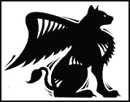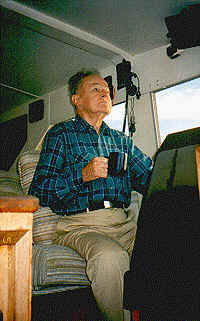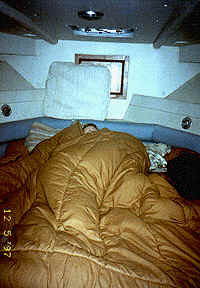
| South Bound |
| North Bound |
| Chart |
| Contact Us |
| The Book |
| Home |
Griffin Update #9: All I want for Christmas
is a Glendinning Engine Synchronizer
Inport, Municipal Marina, Titusville, Florida, 2115 hours, Onboard M/V
Griffin.
After we anchored in the rain last night we went back into the cabin and started our nightly ritual. After a week underway we have it down to a science.
When you run a piece of machinery as hard as we are pushing this boat, you need to check it all out, at least once a day. Our little ship is powered by two Volvo, Turbocharged, After Cooled, Marine Diesel Engines. They each put out 165 horsepower. We also have a Universal 5 Kilowatt Diesel Generator. Every night we pull up the floor in our main living area, called "the main salon" and go through our engine checks. We check the fresh water coolant. (Stbd engine is leaking/venting 1 1/2 quarts a day. Not good to be doing that, but the loss rate is consistent so we will get it sorted out in Florida.) We check the engine oil level. We check/clean the sea water strainer. We check the transmission oil level, and we check the fuel filter/strainer.
When we started this trip, engine checks took about 40 minutes. We have it down to just about 12 minutes at this point, and that's if we aren't hurrying. We always do the checks at night, so in the morning we just light-off the engines and go.
When we anchored last night, the tide was running out. The tidal range in that area of Florida can be as much as 5 feet. We anchored with our bow into the current, facing west. There was a sailboat about a half mile further up the creek who had apparently come in on the high tide and when the tide ran out, they went hard aground. At low tide, they were almost completely out of the water, and leaning over about 45 degrees. I can explain away a lot of things but I'm glad I wasn't that guy trying to convince his wife that heeling at anchor was normal.
 We cooked dinner on the reluctant propane stove, microwaving in the
end to help things along, and then went to bed.
We cooked dinner on the reluctant propane stove, microwaving in the
end to help things along, and then went to bed.
Russell and I got up early and lit off the engines before dawn. We pulled up the anchor and headed out to the channel. The formerly aground sailboat was gone, presumable floated off by the high tide and moved to a better anchorage.
At the intersection of Fort George Creek and the ICW we encountered the tug Sara Kaitlin, pulling 1,000 feet of dredging pipe. She had two other tugs helping here move this monster load down the ICW at 2 knots. We had actually passed her the day before up in Georgia, so it was good to see a familiar friend.
The commercial tugs run 24 hours a day to get where they are going. As they are running at about 1/3 our speed, it is not uncommon to pass the same tug and tow every day for several days. We pull in at night to shower, have a nice meal and sleep. The tug and tow pass us in the night, and we overtake them the next day. Some of those tug crews look pretty filthy! We are glad we are doing it our way.
 Wendy played the role of Kathie Lee on a Carnival Cruise and slept-in
for a couple of hours while Russell and I headed down the waterway. We
have another ICW guide that covers this part of Florida in detail. In
one stretch, just south of Jacksonville, the guide told us to scan the
west bank of the waterway, and if we were lucky, we would see alligators.
We were lucky, and didn't see any!
Wendy played the role of Kathie Lee on a Carnival Cruise and slept-in
for a couple of hours while Russell and I headed down the waterway. We
have another ICW guide that covers this part of Florida in detail. In
one stretch, just south of Jacksonville, the guide told us to scan the
west bank of the waterway, and if we were lucky, we would see alligators.
We were lucky, and didn't see any!
There are three ways we know we are finally in Florida.
1) It is noticeably warmer.
2) There are dolphins jumping out of the water all over the place. We
see them at least once per hour.
3) There are speed zones to slow down for Manatees every few miles it
seems.
The manatee zones are frustrating. We have to slow for anywhere from 1 to 6 miles from our cruising speed of 18-20 mph to a minimum wake speed of about 6. This really limits the distance we can cover in an hour or a day. We ponder the benefits of teaching Darwin vs. Environmentalism in public schools as we crawl along at 6 mph.
We are trying to get to mile 1,000 of the ICW tomorrow night. To make that an attainable objective, it was important for us to get to Titusville, opposite the Cape Kennedy Space Center, by tonight. That was a run for today of 143 miles.
We were clipping along, on again, off again depending on the mythical manatees, all day. Our goal was in reach, then out of reach, then back in reach. Every time we cleared a manatee restricted area and kicked the speed up we got optimistic. Finally, it became obvious that we were going to be late. After dark.
Normally, night operations don't bother me. I sure did enough of it in the Navy. But, being out in open ocean at night is a lot easier, and less stressful, than restricted water navigation in a strange area with unlit navigation marks, and a small crew.
As we came down the Indian River towards Titusville, we used the huge space shuttle assembly building as a reference. We got within 10 miles of Titusville when the sun dropped below the horizon.
Maybe it's because we have been so perseverant in our voyage south in
spite of our obstacles, but we lucked out. The sun set below a high layer
of alto-cumulous clouds. Those are the puffy white clouds you are used
to seeing on sunny days, but usually relatively low. The "alto" in
alto-cumulous means that these clouds are up at 15-20 thousand feet.
Tonight there were no cloud layers below them and the surface so the
alto cumulous dominated the sky. Like a ceiling on the world. This gave
us the most spectacular sunset imaginable! As the sun dropped below the
horizon, the suns rays lit up the bottom of the high clouds in the most
beautiful way. Yellows, oranges, reds, purples. All the colors you can
remember from the best sunsets you have ever seen, but with a difference.

Instead of lighting up the horizon, down close to the earth, as in a regular sunset, this light show was directly over our head. The light reflected down to us back on the water and helped prolong twilight the 30 minutes we needed to sneak into Titusville. We roared in with Wendy driving and Jon and Russell navigating. What an exciting trip!
We went to dinner at a restaurant that could have been the inspiration for Bubba-Gump shrimp. The shrimp soup was out, but we had rock shrimp, regular shrimp, and we could have had many more types of shrimp than I have the time to tell you about. It was the best meal of the trip.
Tomorrow, we leave for the run to Stuart, in south Florida.
Wendy seems to have calmed the trip down. Or, maybe it's that we have finally got the boat sorted out. I'm not going to tempt fate and say it's all down hill from here. Let's get to Stuart before we start slapping ourselves on the back!
Jon, Wendy & Russell
P.S. Glendinning Engine Synchronizers automatically adjust the engines so that when you move the throttle for one engine, the other engine follows suit. Without them, every time we pick up speed after a Manatee zone or passing a sailboat, we have to synch the engines. This entails moving the throttles forward and back very infinitesimal amounts to try and get the engines at exactly the same RPM. If you don't get them in synch they make a terrible drumming noise that drives us all nuts, and isn't good for the engines. Synching by hand is okay for the first 10 or 15 times in the day, but by the 60 or 70th time we are ready to have a machine do it automatically for us.